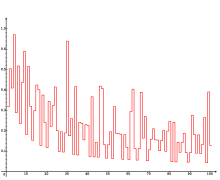Guess by Andrica
The conjecture of Andrica , named after Dorin Andrica is a presumption in the prime gaps .
Let the -th prime number . Then Andrica's conjecture says that the following inequality holds for all natural ones :
Using the -th prime number gap , it can also be formulated as follows:
values
Be it .
Empirically, these values decrease asymptotically for increasing , so it is very likely that the assumption is correct. For everyone with , H. J. Smith's suggestion was confirmed, which was the greatest value found .
Some values, of which it is assumed that they are no longer exceeded for larger ones, can be found in the following table:
|
Follow A084976 in OEIS |
Follow A084974 in OEIS |
Follow A084977 in OEIS |
|---|---|---|
| 4th | 7th | 0.670873 |
| 30th | 113 | 0.639281 |
| 217 | 1327 | 0.463722 |
| 263 | 1669 | 0.292684 |
| 367 | 2477 | 0.260522 |
| 429 | 2971 | 0.256245 |
| 462 | 3271 | 0.244265 |
| 590 | 4297 | 0.228429 |
| 650 | 4831 | 0.215476 |
| 738 | 5591 | 0.213675 |
| ... | ||
| 10655462 | 191912783 | 0.008950 |
Numerical computer calculations confirm the assumption; meanwhile (2005) the prime numbers were tested to. However, formal proof has not yet been provided.
generalization
More generally, one can use the equation
consider and look for the maximum or minimum that satisfies such an equation. You have the equation
- Maximum trivially at , d. H.
- Minimum for the first 1000 primes (and presumably general) at , d. H.
- This is (also known as the ) Smarandache constant referred to.
This gives rise to the generalized Andricean conjecture
It is also believed that
Similar guess
Andrica's conjecture is a tightening of Legendre's conjecture , according to which there is at least one prime number between each and every one.
literature
- Florentin Smarandache : Six Conjectures which Generalize or Are Related to Andrica's Conjecture. In: Octogon. Volume 7, No. 1, 1999, pp. 173-176. arxiv : 0707.2584v1 ; see: Perez
Web links
- Eric W. Weisstein : Andrica's Conjecture . In: MathWorld (English).
- Andrics's Conjecture and Generalized Andrica conjecture on PlanetMath
- ML Perez: Five Smarandache Conjectures on Primes
Individual evidence
- ^ Titu Andreescu: Number Theory. Springer Science & Business Media, 2009, ISBN 978-0-8176-4645-5 , p. PT26 ( limited preview in Google book search).
- ↑ Prime Numbers: The Most Mysterious Figures in Math . John Wiley & Sons, 2005, p. 13.
- ↑ sequence A038458 in OEIS
- ↑ It is not to be confused with the sixteen Smarandache constants n , which are related to the Smarandache function .























